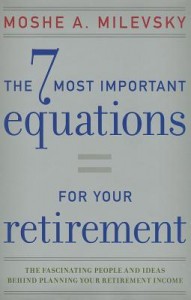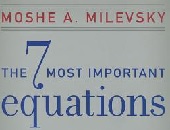I stumbled on a small piece of paradise when I came across Milevsky’s book, The 7 Most Important Equations for Your Retirement: The Fascinating People and Ideas Behind Planning Your Retirement Income. This book is stuffed with anecdotes about the mathematical geniuses who derived the equations that are central to retirement planning.
“Getting an equation named after you isn’t easy. Unlike a building, hospital ward or even a business school, money can’t buy you this sort of fame,” Milevsky writes. “You must own a very sharp set of knives.”
In my undergrad days in chemistry, I recall the moment it dawned on me to pay attention to the names. Boyle’s Law, the Arrhenius equation, the Nernst equation (to name a few, and in no particular order). I learned: if there’s a name attached, know it for the exam. (The Ideal Gas Law was the exception that proved the rule.) Furthermore, I discovered that whenever there was a scrap of information about the scientist involved, such as Nernst’s development of the electric piano or Arrhenius’ meddling in the Nobel Prize selections, it was easier to remember the scientific contribution.
Was it just me, or does the “human connection” ease the learning of abstract concepts? My dream textbook would be the special geeks’ issue of People magazine interleaved with pages from Atkins’ Physical Chemistry 8th edition.
 Each core chapter starts with the equation boldly presented—logarithms and exponents and infinite sums hanging out everywhere like washing on a Monday—then sails into a mini-bio of the person it’s named after. There’s a brief explanation about why the equation is important to retirement planning. But that’s not enough for Milevsky, the born educator. He provides a worked example in the most reader-friendly way possible, plugging in different values, coming up with different scenarios, to show us why the equation is a good thing to have in the financial planning toolkit.
Each core chapter starts with the equation boldly presented—logarithms and exponents and infinite sums hanging out everywhere like washing on a Monday—then sails into a mini-bio of the person it’s named after. There’s a brief explanation about why the equation is important to retirement planning. But that’s not enough for Milevsky, the born educator. He provides a worked example in the most reader-friendly way possible, plugging in different values, coming up with different scenarios, to show us why the equation is a good thing to have in the financial planning toolkit.
The core chapters are designed to answer 7 big questions:
- How long will my nest egg last? Fibonacci’s calculation of burn rate for fixed spending and fixed interest rate
- How long will I spend in retirement? The Gompertz law of mortality, quantifying the randomness of human longevity
- Will I get my money’s worth from a pension annuity? Halley’s pricing of pension annuities
- What is a proper spending rate? Fisher’s sustainable spending rate
- What balance of risky stocks versus safe cash should I have? Samuelson’s proportion of risky assets in asset allocation
- What is my financial legacy today? Huebner’s human life value equation (actually, he promoted Halley’s work) or the value of a death benefit
- Is my current plan sustainable? Komolgorov’s continuous probability calculation, applied here to a sustainable retirement plan
Milevsky must be a hoot in the lecture hall. “Let’s put on our construction hats and try to blow up the equation with some extreme cases,” he writes in a section about testing the internal limits of the Gompertz Equation. Of the formidable Edmond Halley he writes, “to astronomers and geophysicists, [he] is a celebrity, an Elvis Presley of the Renaissance. Like Elvis, Halley continues to be cited long after his time.” Regarding Irving Fisher he writes, “Fisher was one of the most enthusiastic defenders [of Prohibition]… which is completely uncharacteristic for an academic economist, most of whom head straight for the bars once a day full of equation manipulation is over.”
Besides possessing a flair for translating abstruse analytics into colloquial examples, Milevsky is not afraid to show his own fallibility, such as when he recounts an interchange between himself and Samuelson. He turns this to good pedagogic effect when he explains the “recency effect.”
Milevsky is aware that the average reader may have encountered the famous names connected to other facts (for example, Fibonacci’s number, Halley’s comet) and he includes a brief description of the other “claim to fame” (or infamy, in the case of Fisher’s hubris on the eve of the Great Depression).
This book provides a list of references and sources, and an index. The author provides numerical examples, mainly to comment on the expected change in outcome, as the variables are changed. Although worked examples are discussed, It is not a plug-in-your-own-numbers workbook.
If you want to ease into retirement planning through the relatively painless and interesting historical route, or if you are curious to see how the questions on retirement were addressed by deep thinkers, I recommend this book highly. ª
Excel worksheets based on this book can be found at the QWeMA Group website: http://www.qwema.ca/index.php/our-calculators/
March 2017 update: Tom Verde of the New York Times quotes Moshe Milevsky on tontines.

